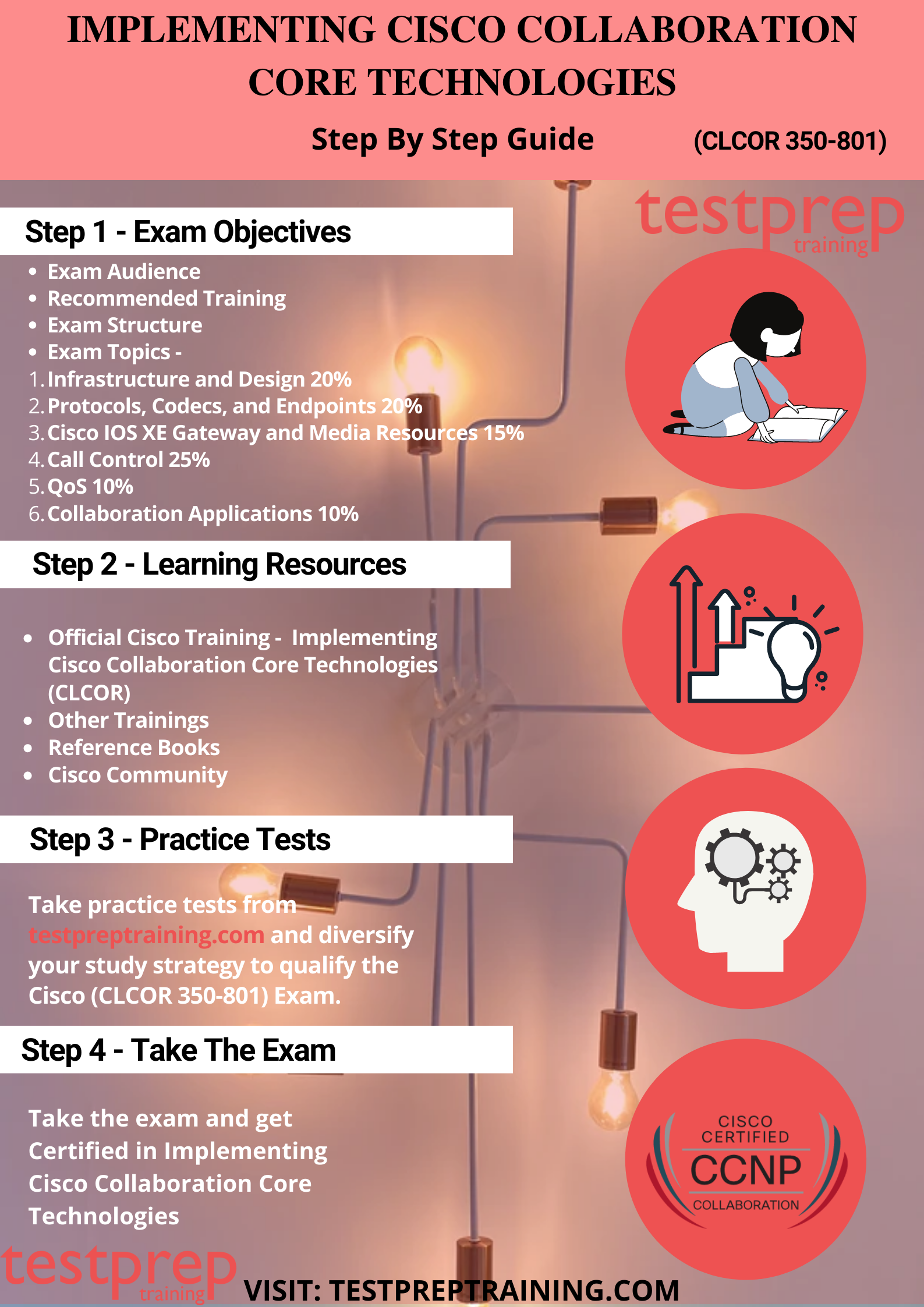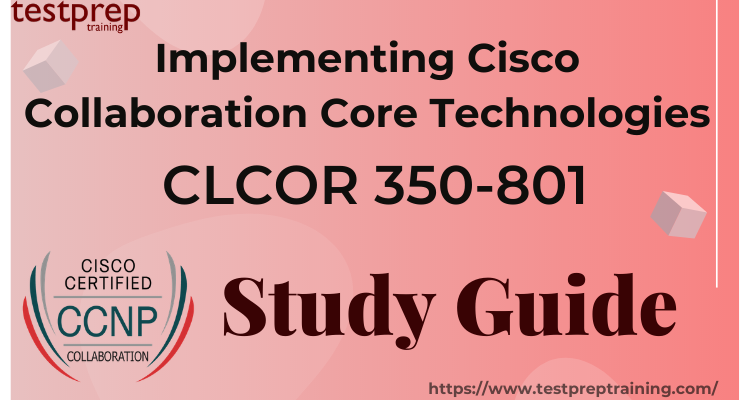CLCOR 350-801 is an exam code for the CCNP (Cisco Certified Network Professional) Collaboration certification. This test is designed to evaluate a candidate’s advanced-level knowledge and abilities in setting up and managing Cisco collaboration solutions.
The CCNP Collaboration certification validates a candidate’s ability to design, implement, configure, and troubleshoot Cisco collaboration and unified communications solutions. This certification includes various technologies like voice, video, collaboration, and messaging. The exam is taken on a computer and contains multiple-choice questions. You have 120 minutes to complete it, and to pass, you need a score between 825 and 850 out of 1000.
CLCOR 350-801: CCNP Collaboration Exam Glossary
Here are some terms and concepts that are important to know for the CLCOR 350-801 exam:
- Collaboration: The process of working together to achieve a common goal.
- Unified Communications (UC): A collection of communication tools and technologies that work together, enabling people to chat and work together instantly.
- Cisco Unified Communications Manager (CUCM): A call control platform that provides call routing, signaling, and call processing services for Cisco collaboration solutions.
- Cisco Unity Connection: A messaging platform that provides voicemail, unified messaging, and other messaging services.
- Cisco Unified IM and Presence: A collaboration platform that provides instant messaging, presence, and chat capabilities.
- Cisco TelePresence: A video conferencing and collaboration solution that enables users to communicate and collaborate in real-time.
- Session Initiation Protocol (SIP): A signaling protocol used in VoIP (Voice over Internet Protocol) communication.
- Real-time Transport Protocol (RTP): A protocol used for transmitting audio and video over IP networks.
- Quality of Service (QoS): A set of techniques used to prioritize and manage network traffic to ensure the best possible performance for critical applications.
- Multiprotocol Label Switching (MPLS): A routing technique used to speed up and shape network traffic flow.
- Voice and Video Codecs: Algorithms that compress and decompress voice and video data for transmission over a network.
- Call Admission Control (CAC): A process that controls the number of calls that can be initiated or received by a system to prevent overload.
- Domain Name System (DNS): A system that translates domain names into IP addresses.
- Simple Network Management Protocol (SNMP): A method used to keep an eye on and control network devices.
- Secure Real-Time Transport Protocol (SRTP): An encryption protocol used for securing real-time data such as voice and video over IP networks.
CLCOR 350-801: CCNP Collaboration Exam Guide
Here are some official resources for the CLCOR 350-801 exam:
- Exam Topics: The official exam topics for the CLCOR 350-801 exam can be found on the Cisco website: https://www.cisco.com/c/en/us/training-events/training-certifications/exams/current-list/clcor-350-801.html
- Study Materials: Cisco offers a range of study materials for the CLCOR 350-801 exam, including books, video courses, and e-learning modules. These can be found on the Cisco website or through Cisco authorized training partners.
- Exam Preparation: Cisco offers a variety of exam preparation materials, including practice exams, study groups, and discussion forums. These resources can be found on the Cisco Learning Network: https://learningnetwork.cisco.com/community/certifications/ccnp-collaboration
- Exam Registration: Candidates can register for the CLCOR 350-801 exam through the Pearson VUE website: https://home.pearsonvue.com/cisco
- Exam Policies: Before taking the exam, candidates should familiarize themselves with the exam policies, including the exam retake policy, exam delivery method, and exam security policies. These can be found on the Cisco website: https://www.cisco.com/c/en/us/training-events/training-certifications/exams/policies.html
CLCOR 350-801: CCNP Collaboration Exam Tips and Tricks
Here are some tips and tricks to help you prepare for the CLCOR 350-801 exam:
- Study the exam topics thoroughly: The exam topics are the most important areas to focus on when studying for the exam. Make sure to study each topic in detail and understand the concepts thoroughly.
- Use official study materials: The official study materials provided by Cisco are the most reliable and comprehensive resources for preparing for the exam. Use these resources to build a strong foundation of knowledge.
- Practice with lab exercises: Hands-on lab exercises are a great way to reinforce your understanding of the technologies covered in the exam. Use lab exercises to gain practical experience and familiarity with the Cisco collaboration solutions.
- Join a study group: Joining a study group can be helpful in sharing knowledge and studying collaboratively. You can also get insights and tips from other candidates who are preparing for the same exam.
- Take practice exams: Practice tests are useful for checking what you know and finding areas where you can do better. Use them to get used to the test style and the kinds of questions you might encounter.
- Manage your time effectively: The exam has a strict time limit, so it’s important to manage your time effectively during the exam. Make sure to allocate enough time for each question and don’t spend too much time on difficult questions.
- Read each question carefully: Carefully read each question and make sure you understand what is being asked. Don’t rush through the questions, as this can lead to careless mistakes.
- Stay calm and focused: Feeling anxious during the exam is common, but try to stay relaxed and concentrated. Breathe deeply, maintain a positive attitude, and have confidence in your preparation.
Study Guide for Cisco CLCOR 350-801 Exam
The roadmap to your success is only complete with the help of right preparatory resources. You need to stay consistent and determined. It is very important that you follow a proper study pattern while learning from authentic and genuine resources. This step by step Study Guide will be your support throughout your journey towards the exam.

Step 1 – Review Exam Objectives
The course domains and modules act as a blueprint for the exam. The syllabus for should be very clear in your mind. Given the vast concepts that this exam covers, course outline plays an important role. Therefore you must familiarise yourself with the Official Guide for Cisco CLCOR 350-801 exam before commencing its preparations to excel. This exam covers the following domains-
Domain 1- Infrastructure and Design [20%]
Firstly, this domain covers concepts to describe the key design elements of the following, pertaining to the Cisco Collaboration architecture as described in the SRND/PA. Also, describing the purpose of Edge devices in the Cisco Collaboration architecture such as Expressway and Cisco Unified Border Element. Further, configuring these network components to support Cisco Collaboration solutions. Also, troubleshoot these network components in a Cisco Collaboration solution and explain these components to support Cisco Collaboration solutions.
Domain 2- Protocols, Codecs, and Endpoints [20%]
Secondly, this domain includes troubleshoot these elements of a SIP conversation and identify the appropriate collaboration codecs for a given scenario. Also, configure codec negotiations, deploy SIP endpoints and troubleshoot collaboration endpoints.
Domain 3- Cisco IOS XE Gateway and Media Resources [15%]
Further, this domain focuses on concepts to configure these voice gateway elements and configure ISDN PRI/BRI. Then, troubleshoot ISDN PRI/BRI and configure and verify the MGCP. Also, identify the appropriate media resources for a given scenario (hardware and software).
Domain 4- Call Control [25%]
This domain aims at building the understanding of describing the Cisco Unified Communications Manager digit analysis process. Also, implementing toll fraud prevention on Cisco Unified CM, and configuring globalized call routing in Cisco Unified CM. Moreover, describing Mobile and Remote Access (MRA)
Domain 5- QoS [10%]
This domain is much focused on describing problems that can lead to poor voice and video quality. Also, describing the QoS requirements for these application types (voice and video). Further, describing the class models for providing QoS on a network and the purpose and function of these DiffServ values as it pertains to collaboration. Then, describing QoS trust boundaries and their significance in LAN-based classification and marking. Furthermore, describing and determining location-based CAC bandwidth requirements. Moreover, configuring and verifying LLQ (class-map, policy-map, service policy)
Domain 6 – Collaboration Applications [10%]
Lastly, this domain aims at configuring Cisco Unity Connection mailbox and MWI, and Cisco Unity Connection SIP integration options to call control. Also, describe Cisco Unity Connection call handlers and Cisco Unified IM&P protocols and deployment like XMPP and High availability. Further, deploy Cisco Jabber on-premises.
Step 2 – Explore all Learning Resources
In the market, there are many resources to help you prepare for the Cisco CLCOR 350-801 exam. These resources provide the necessary information to pass the exam. Here are some top-rated resources:
Resource 1 – Official Cisco Training
Implementing Cisco Collaboration Core Technologies (CLCOR)
This course helps learners prepare for Cisco CCNP Collaboration and CCIE Collaboration certifications, which are advanced-level roles focused on implementing and operating Cisco collaboration solutions. The course has specific objectives, including understanding Cisco collaboration solutions architecture, setting up Cisco Unified Communications Manager features, configuring Cisco gateways for PSTN access, managing calling privileges, preventing toll fraud, defining QoS and its models, and more.
Resource 2 – Join the Cisco Community
The Cisco community is referred to as the place for Networking Professionals so that they can engage with each other and essentially with Cisco in order to share knowledge, excavating explanations to common dilemmas, and extending their potentials with the Cisco products. Here, you can collaborate with peers and Cisco on all aspects of the networking. It comprises of Cisco Digital Network Architecture, routing, switching, network management, and many more.
Step 3 – Evaluate with Practice Test
Finally, it is time to check your preparations. Self-Evaluation is the key and hence your next step is to attempt practice tests. The more you’re going to practice, the better for you. These practice tests provide you with the real exam environment and also help you analyse areas that need improvement. Strengthening your weaker domains will surely help you pass with flying colours. Also, attempting multiple practice tests is vital to boost your confidence. So, outperform yourself with each subsequent test to be fully ready on the exam day. Start practising Now!



